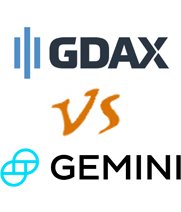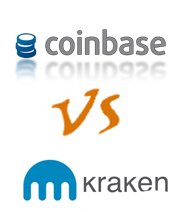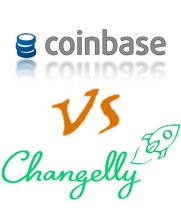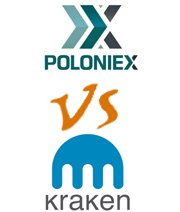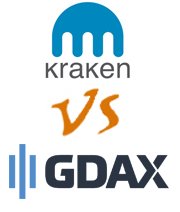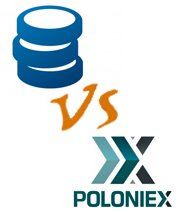
Table of Contents
- 1. What’s a Counterparty?
- 2. Digital Assets
- 3.A Decentralized Exchange
- 4. Distributing Payments
- 5. How Contracts Work
- 6. More Features
- 7. The Future of Counterparty
- 8. Trading, Buying, and Storing XCP
- 9. Counterparty vs Ethereum
- 10. Counterparty XCP vs Rootstock
- 11. Counterparty XCP vs Omni
- 12. Frequently Asked Questions
- 13. Conclusion
When most people look at blockchains, they just think of cryptocurrencies. While these two things are intimately connected, blockchain technology is good for all kinds of transactions. While some platforms have allowed the transfer of digital assets in a way that’s compatible with their blockchain, Bitcoin hasn’t really had one – or so we thought.
Counterparty is a platform that allows for the creation and trading of digital assets on the Bitcoin blockchain. It’s been developed since 2024, but became overshadowed by Ethereum and its ERC-20 token protocols.
Using our guide below, you’ll get acquainted with what Counterparty is and how it works. And if you’re looking for more great altcoins to consider investing in, check out our list of the best altcoin investments for 2024.
What’s a Counterparty?
A counterparty, in financial terms, is just the other person or group you’re doing a transaction with. It’s a fundamental part of economics: one party has an asset that they wish to sell or trade, and the other party has to exist in order for there to be some sort of transaction. The Counterparty platform, therefore, places importance on this second party and makes it the main focus of the network: to find everyone a counterparty that suits their transactional needs.
Digital Assets
As we mentioned earlier, most people just associate crypto coins or tokens with blockchains. But the truth is that anything that has a value to it can be considered an asset. What kinds of things, you might ask? Well, they could be anything from stock in a company to a digital certificate representing an actual item. This is what Counterparty allows you to create.
Counterparty as a platform consists of the protocols, rules, and other things that are needed to create an asset that works with the Bitcoin blockchain. The same idea governs ERC-20 tokens, except for the Ethereum blockchain.
Since it works on the Bitcoin blockchain, it can use information from the blockchain for executing contracts, but that also means you have to pay a mining fee for each transaction.

A Decentralized Exchange
Part of the Counterparty system is its decentralized exchange, where assets can be traded.
What’s the difference between a centralized and decentralized exchange? A centralized exchange is where one entity matches buyers and sellers, for which they take a fee. All the power is concentrated in one place, meaning you have to trust them with your money or your information.
On the other hand, a decentralized exchange requires no third party to match you up, no central institution to match up transactions and take fees. Smart contracts make sure no money or assets have changed hands before both parties are satisfied. More and more of these are to be seen every year, such as Ethereum and Waves.
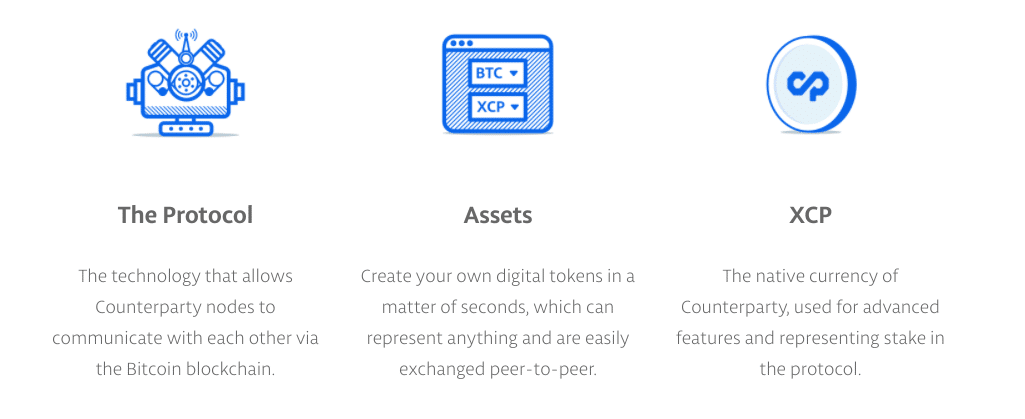
Distributing Payments
Counterparty has a system set up for people to distribute payments according to assets to those to whom they wish to give things. For example, you can give a number of people assets that represent the amount of stock or investments they hold in your company, or board members can have assets representing the amount of voting power they have.
Those assets can be used in Counterparty as a way of determining how much Bitcoin to distribute to them.
How Contracts Work
Like Ethereum’s smart contracts, Counterparty has its own contract system that allows you to create contracts that work on the Bitcoin blockchain. They can be used for person-to-person transactions, or they could also be used as a part of a decentralized app – for example, if you wanted to program an app that automatically invests in a certain coin if certain market trends are seen.
Better yet, you can link these smart contracts to your personal (or your business’s) programs and network to integrate your company with Bitcoin’s blockchain seamlessly.
All of this isn’t new – Ethereum’s been offering these features for a while – but they’re important for any fan of Bitcoin to keep in mind.
More Features
Counterparty will soon feature Lightning Network support. The Lightning Network was recently launched by Bitcoin, a way of lightening the burden on Bitcoin’s networks by processing transactions off-chain. You can also use multi-signature addresses, important for any transaction involving a party of more than one person. A contract or transaction in these cases won’t execute until all individuals in one part have signed off on it – important for business use. This feature will make things more robust and more secure, making sure no individual needs to be given total power.
The Future of Counterparty
This project has been around since 2024, but remains under development, even as other projects like Ethereum have blown past it. The team is loosely-knit, with people coming and going over the years, and the team as it currently stands makes the project look like a volunteer, part-time affair. As such, there’s no dedicated or sure “road map” for the future of this project. Honestly, that might be partly why they haven’t developed as much as they could have.
Counterparty recently broke off with Storj, a storage-based platform which was developing a token for Counterparty’s storage feature. Not great news. As such, the price hasn’t gone up much in recent times. If you’re in the market for promising crypto coins, you can should check out this updated list of recommended altcoins for investing in 2024.
Trading, Buying, and Storing XCP
The main asset (and the first one on the platform) is the XCP token. This token is used to create assets and execute certain transactions on the Counterparty network. Unlike many coins, there there was no ICO, another point which probably led to the project going largely unnoticed.

That said, you can buy XCP on exchanges like Poloniex and Bittrex. In most cases, you’ll need Bitcoins to trade for it.
XCP can be stored on the Counterwallet, as well as many other wallet choices offered on the website’s main download page.
Counterparty vs Ethereum
These are similar projects, but different in their focus. Both support the creation and trading of digital assets on their networks, transactions which are recorded on their respective blockchains. While Counterparty works on the Bitcoin blockchain, Ethereum works on the Ethereum blockchain. Bitcoin assets aren’t as prevalent as Ethereum assets, due to the popularity of Ethereum and the ERC-20 protocol. Counterparty is going to make use of the Lightning Network to lighten network load, while Ethereum plans to use the tactic known as “sharding” to accomplish the same goal.
www.parkviewortho.com/wp-content/languages/new/levaquin.html
Ethereum is more robust and has more active development, while Counterparty is a slower affair.
Counterparty vs Rootstock
These are similar projects. Both of these are smart contract platforms, and both of them work with the Bitcoin blockchain. Both have a focus on security in transactions, and both have a desire to make transactions happen faster – Counterparty will take advantage of The Lightning Network, while Rootstock is making use of unique protocols. Rootstock is mainly focused on financial transactions and scalability, while Counterparty is lower-scale and supports digital assets of all kinds – not necessarily financial transactions.
Counterparty vs Omni
Again, two similar platforms. Both of these projects aim at creating a way for people to make and trade digital assets, both on the Bitcoin blockchain. Both support P2P transactions, and both offer decentralized exchanges for trading. Counterparty offers mult-signature transactions, while it isn’t clear that Omni offers something similar. Counterparty doesn’t seem to have a full-time team, but Omni on the other hand has a dedicated team that you can read about easily on their main website. Omni also looks to have more of a community than Counterparty.
Frequently Asked Questions
- Is Counterparty the same as XCP?
Yes, XCP is the short-hand way to refer to Counterparty tokens. - Is there a Counterparty wallet?
Yes, there are several options, downloadable from the main site. - What’s the price of Counterparty?
$22.46, last we saw. - Is Counterparty on Reddit?
Yes. - How does Counterparty perform vs Ethereum?
Check out the section above for our comparison. - Can I buy XCP?
Yes, with Bitcoin, mainly. - Is there a risk with Counterparty’s Bitcoin capability?
It doesn’t seem so, since Bitcoin has safety measure built into its blockchain. - What’s the best Counterparty wallet?
We’d go with Counterwallet, but there are other choices depending on your preferences. - What’s the price prediction for Counterparty?
Hard to say, but it could go up if it gets its new features implemented. - Where can I read a review of the Counterparty coin?
www.parkviewortho.com/wp-content/languages/new/cialis.html
Reddit, Medium, or on crypto blogs. - Where can I read Counterparty coin news?
On Twitter and Reddit, mainly. - Does Counterparty support a contract?
www.parkviewortho.com/wp-content/languages/new/amoxil.html
Yes, it supports smart contracts. - Where can I read a review of Counterparty wallet options?
Probably on crypto blogs and on Reddit. - Is Counterparty on Bitcointalk?
Yes. - Does Counterparty work with an explorer?
Yes.
Conclusion
Right now Ethereum looks to be zooming right past Bitcoin in its capabilities, pioneering smart contracts and dApps, with businesses getting onboard and new developers and projects forming their own networks on Ethereum. Bitcoin, on the other hand, has projects like Counterparty that look like they’re trying, but will likely not be able to surpass Ethereum – at least, not unless they kick things into high gear. With Storj’s abandonment of Counterparty for Ethereum, it made their token devalue very quickly, and wasn’t a good sign. Right now what this project needs is more development, more active members, and more partnerships. Then maybe Counterparty will be the next big thing.
Counterparty’s price was around $22, last we saw – not bad, but a little pricey for those just getting started. If you want to read about the most promising recent cryptocurrencies, click here for the best ones to invest in in 2024.








